1929 Chevrolet Truck, a symbol of American ingenuity and resilience, emerged during a pivotal time in automotive history. The roaring twenties were in full swing, marked by economic prosperity and a surge in car ownership. Chevrolet, a rising star in the industry, capitalized on this momentum by introducing a truck that would become synonymous with hard work and dependability.
This article delves into the history, design, and lasting impact of the 1929 Chevrolet truck, exploring its role in shaping the automotive landscape and its enduring appeal.
The 1929 Chevrolet truck was a testament to the company’s commitment to providing reliable transportation for both businesses and individuals. Its sturdy construction, powerful engine, and adaptable design made it a popular choice for a wide range of applications. From hauling goods to transporting families, the 1929 Chevrolet truck became an integral part of American life.
History and Background
The 1929 Chevrolet truck emerged during a pivotal period in American history, marked by rapid industrialization and the rise of the automobile. The roaring twenties had witnessed a surge in car ownership, and trucks were increasingly becoming essential for businesses and individuals alike.
Chevrolet, as a major player in the automotive industry, played a significant role in shaping this transformation.
Chevrolet’s Role in the Automotive Industry
Chevrolet, founded in 1911 by Louis Chevrolet and William Durant, quickly established itself as a leading manufacturer of affordable and reliable vehicles. By the late 1920s, the company had become one of the largest automobile producers in the world. Chevrolet’s success was attributed to its commitment to mass production, innovative engineering, and a strong marketing strategy.
The company’s trucks, known for their durability and versatility, were well-suited to the needs of a growing economy.
Economic and Social Conditions
The 1920s was a period of economic prosperity in the United States, fueled by industrial growth, rising wages, and widespread consumerism. This economic boom led to a surge in demand for trucks, as businesses sought to transport goods and materials more efficiently.
The rise of the trucking industry also contributed to the development of a nationwide network of roads and highways, further enhancing the utility of trucks.
Design and Features: 1929 Chevrolet Truck
The 1929 Chevrolet truck, while built during the nascent years of the automotive industry, showcased innovative design elements that contributed to its success. It was a sturdy and reliable workhorse, designed to meet the demands of various industries and individuals.
The design of the 1929 Chevrolet truck was a blend of functionality and simplicity. The truck featured a robust chassis, a powerful engine, and a variety of body styles to suit different needs. Its design was characterized by its simplicity and efficiency, making it a popular choice for businesses and individuals alike.
Engine
The 1929 Chevrolet truck was powered by a 194-cubic-inch (3.2 L) four-cylinder engine. This engine was capable of producing 35 horsepower (26 kW) and was known for its durability and reliability. The engine featured a cast-iron block and a head, and it used a carburetor for fuel delivery.
Chassis
The 1929 Chevrolet truck featured a sturdy ladder-frame chassis that was designed to withstand the rigors of heavy-duty use. The chassis was constructed from steel and was reinforced at key points to provide additional strength. The chassis also incorporated a suspension system that provided a smooth ride even on rough terrain.
Body Styles
The 1929 Chevrolet truck was available in a variety of body styles, including:
- Pickup truck:This was the most popular body style, and it was designed for hauling goods and materials. The pickup truck featured an open bed that could be accessed from the sides and the rear.
- Stake truck:The stake truck featured a flatbed with removable stakes that could be adjusted to accommodate different cargo sizes.
- Panel truck:The panel truck featured a closed body that provided protection for cargo from the elements. This body style was popular for businesses that transported goods that required protection.
- Chassis cab:The chassis cab was a bare chassis that could be customized with a variety of body styles. This option was popular for businesses that needed a truck for specific purposes.
Unique Features
The 1929 Chevrolet truck offered several unique features that differentiated it from other trucks of the era:
- Four-wheel brakes:This feature was not common on trucks of the time, and it provided improved braking performance.
- Electric starter:This feature made starting the engine easier and more convenient.
- Full-floating rear axle:This feature reduced stress on the axle and improved its durability.
Production and Sales
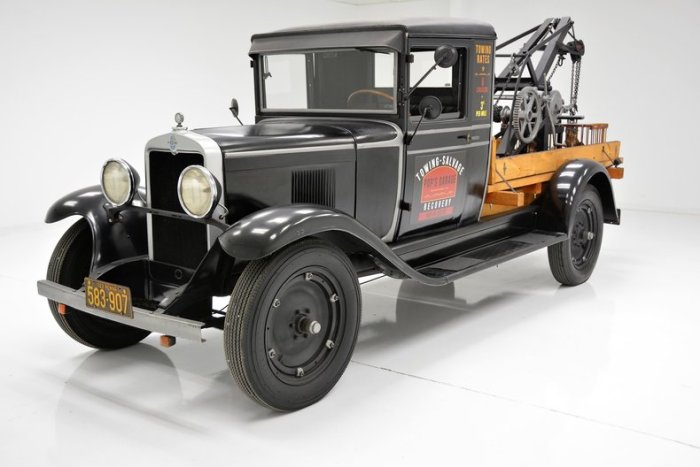
The 1929 Chevrolet truck, a significant vehicle in the history of the brand, was produced in substantial numbers, reflecting its popularity and the growing demand for commercial vehicles during the era. This section delves into the production volume, target market, and sales figures of the 1929 Chevrolet truck.
Production Volume
Chevrolet produced a considerable number of trucks in 1929, solidifying its position as a leading manufacturer of commercial vehicles. While precise figures for the 1929 model year are difficult to find, available data indicates that Chevrolet produced over 100,000 trucks in 1929.
This robust production volume reflects the rising demand for trucks across various industries.
Target Market and Industries
The 1929 Chevrolet truck was designed to cater to a diverse target market, serving various industries. The truck’s versatility made it suitable for a wide range of applications, including:
- Delivery and Transportation:The truck was widely used by businesses for delivering goods, transporting materials, and providing services. Its durability and reliability made it a suitable choice for handling demanding tasks.
- Agriculture:Farmers relied on the Chevrolet truck for hauling crops, transporting livestock, and performing other agricultural tasks. Its robust design and ample load capacity made it an ideal choice for rural applications.
- Construction:The truck was employed in construction projects for transporting building materials, hauling equipment, and supporting construction activities. Its strength and ruggedness made it well-suited for handling heavy loads and rough terrain.
- Commercial Businesses:Businesses of all sizes relied on the Chevrolet truck for various operations, from delivering products to transporting employees and equipment. Its versatility and affordability made it a popular choice for commercial fleets.
Sales Figures and Contributing Factors
While precise sales figures for the 1929 Chevrolet truck are not readily available, it’s evident that the model enjoyed considerable success in the market. Several factors contributed to its popularity:
- Affordable Price:Chevrolet was known for its affordable vehicles, and the 1929 truck was no exception. Its competitive pricing made it accessible to a wide range of customers, including small businesses and individuals.
- Durability and Reliability:Chevrolet trucks were renowned for their robust construction and reliable performance. This reputation for quality instilled confidence in buyers, making the 1929 model a popular choice for businesses and individuals who relied on their vehicles for daily operations.
- Versatility and Adaptability:The 1929 Chevrolet truck was available in various configurations, catering to diverse needs. This adaptability allowed customers to select the model that best suited their specific requirements, contributing to its broad appeal.
- Growing Demand for Commercial Vehicles:The 1920s witnessed a surge in economic activity and industrial growth, leading to a rising demand for commercial vehicles. Chevrolet capitalized on this trend, producing trucks that met the growing needs of businesses and industries.
Impact and Legacy
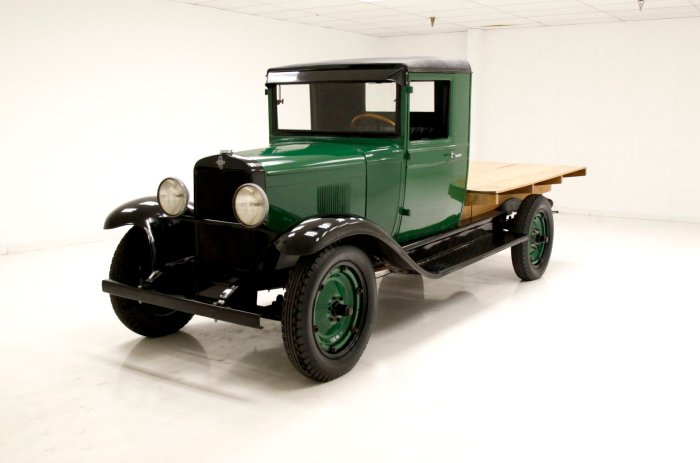
The 1929 Chevrolet truck played a pivotal role in shaping the automotive industry, leaving an enduring legacy that continues to influence truck design and transportation practices today. Its innovative features and affordability made it a popular choice for businesses and individuals alike, contributing significantly to the growth of the trucking industry and the transformation of transportation and logistics.
The 1929 Chevrolet Truck, a symbol of American resilience and ingenuity, represented a pivotal moment in the evolution of the automotive industry. Fast forward to the 1990s, and Chevrolet continued to innovate, releasing the 1990 Chevrolet SS , a powerful muscle car that captured the hearts of enthusiasts.
While these two vehicles are separated by decades of technological advancements, they both embody the spirit of Chevrolet – a commitment to building vehicles that are both dependable and exciting.
Impact on the Automotive Industry
The 1929 Chevrolet truck’s impact on the automotive industry is evident in its contributions to several key areas:* Mass Production:Chevrolet’s adoption of assembly line production techniques, pioneered by Henry Ford, made trucks more affordable and accessible to a wider market. This revolutionized the automotive industry, paving the way for mass production of vehicles.
Technological Advancements
The truck incorporated innovative features like a six-cylinder engine, a four-speed transmission, and a sturdy frame, setting new standards for truck design and performance. These advancements influenced subsequent truck models and helped to drive the industry forward.
Increased Accessibility
The 1929 Chevrolet truck’s affordability made it a practical option for small businesses and individuals, leading to a surge in truck ownership and a significant expansion of the commercial vehicle market. This accessibility contributed to the growth of the trucking industry and the development of new transportation and logistics solutions.
Impact on Transportation and Logistics, 1929 Chevrolet Truck
The 1929 Chevrolet truck’s influence on the transportation and logistics sectors is undeniable. Its introduction led to several significant developments:* Expansion of Road Networks:The increasing use of trucks spurred the development and expansion of road networks, facilitating long-distance transportation and connecting rural areas to urban centers.
This expansion played a crucial role in the growth of the trucking industry and the development of a more efficient transportation system.
Growth of the Trucking Industry
The truck’s affordability and reliability made it a popular choice for businesses of all sizes, leading to a surge in the trucking industry. This growth created new jobs, stimulated economic activity, and transformed the way goods were transported across the country.
Evolution of Logistics Practices
The 1929 Chevrolet truck’s introduction paved the way for the development of more efficient logistics practices. The truck’s versatility and capacity allowed businesses to transport larger quantities of goods over longer distances, leading to improvements in supply chain management and distribution networks.
Enduring Legacy
The 1929 Chevrolet truck’s legacy extends beyond its impact on the automotive industry and transportation sector. Its influence can be seen in:* Truck Design:The truck’s design elements, including its sturdy frame, powerful engine, and functional features, have inspired subsequent truck designs, shaping the evolution of trucks from their early beginnings to modern-day models.
Brand Recognition
The Chevrolet brand, established through the success of the 1929 truck and other models, has become synonymous with quality, reliability, and affordability, contributing to the enduring popularity of Chevrolet trucks today.
Cultural Impact
The 1929 Chevrolet Truck was a workhorse, known for its reliability and durability. While sharing some design similarities with its predecessor, the 1930 Chevrolet Truck saw several updates, including a more powerful engine and a redesigned grille. Despite these changes, the 1929 model remained a popular choice for businesses and individuals seeking a dependable vehicle for hauling and transporting goods.
The 1929 Chevrolet truck played a significant role in shaping American culture, becoming a symbol of hard work, innovation, and progress. Its image has been immortalized in popular culture, appearing in films, television shows, and literature, reflecting its lasting impact on society.
Notable Examples and Stories
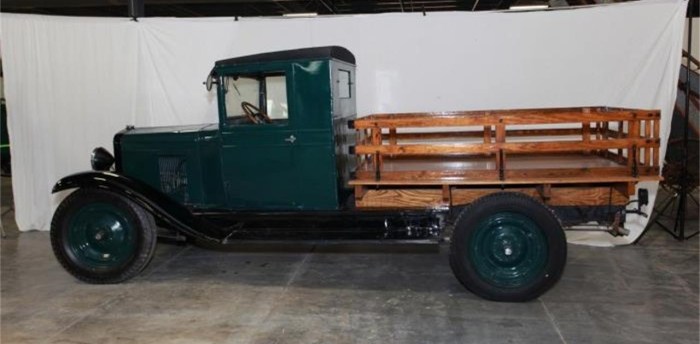
The 1929 Chevrolet truck played a significant role in various sectors, leaving behind a legacy of hard work and resilience. From its use in agriculture and construction to its involvement in the Great Depression, the truck’s impact can be seen in numerous stories and anecdotes.
Notable Examples
The 1929 Chevrolet truck was a popular choice for businesses and individuals across the United States. Here are some notable examples of its use:
- Agriculture:Farmers relied on the Chevrolet truck for transporting crops, livestock, and supplies. Its durability and reliability made it an ideal choice for the demanding conditions of agricultural work. For example, the truck was used to haul hay bales, transport cattle to market, and deliver produce to local grocery stores.
- Construction:The truck’s strength and payload capacity made it suitable for hauling building materials and equipment. It was a common sight at construction sites, where it was used to transport bricks, lumber, and concrete. The Chevrolet truck was also used to tow trailers, which further expanded its utility in construction projects.
- Delivery Services:The Chevrolet truck was used by businesses of all sizes for delivering goods and services. Its versatility and fuel efficiency made it a cost-effective option for transporting packages, groceries, and other items. For instance, the truck was used by delivery companies to transport goods to homes and businesses, and by grocery stores to deliver orders to customers.
Stories and Anecdotes
The 1929 Chevrolet truck was more than just a vehicle; it was a symbol of hard work and resilience, especially during the Great Depression. Many stories and anecdotes illustrate its impact on people’s lives.
- The Farmer’s Lifeline:During the Dust Bowl, farmers in the Midwest relied heavily on their Chevrolet trucks to transport their families and belongings to safer locations. The trucks were also used to haul water and supplies to struggling communities, providing a lifeline during a time of great hardship.
The 1929 Chevrolet Truck, a testament to early automotive ingenuity, paved the way for generations of Chevrolet trucks. Fast forward to 1989, and Chevrolet introduced the 1989 Chevrolet 1500 , a pickup that embodied both durability and modern design. While the 1929 model was known for its simplicity and reliability, the 1989 Chevrolet 1500 showcased advancements in comfort and technology, highlighting the evolution of the Chevrolet truck line over the decades.
- The Entrepreneur’s Partner:The Chevrolet truck was a crucial tool for small businesses during the Great Depression. It allowed entrepreneurs to transport their goods to market, deliver services to customers, and keep their businesses afloat during difficult economic times.
- The Family’s Companion:Many families relied on the Chevrolet truck for transportation, especially during the Great Depression. It was used to take children to school, transport groceries, and go on family outings. The truck served as a symbol of family unity and resilience during a time of great uncertainty.
Restoration and Preservation
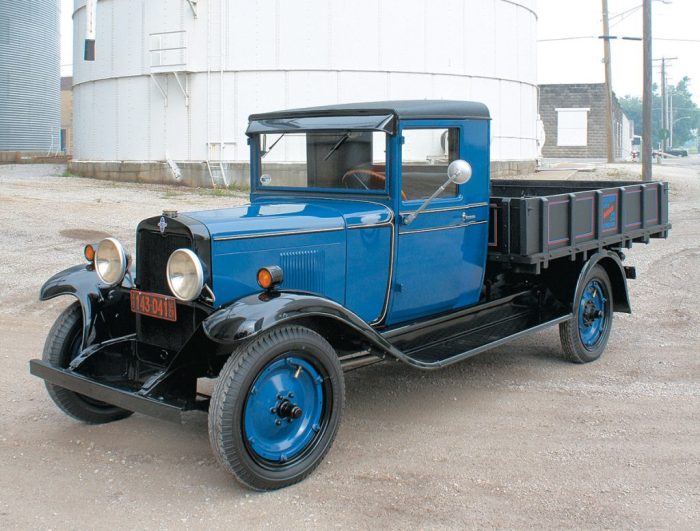
Restoring a 1929 Chevrolet truck is a rewarding but challenging endeavor. These vehicles, a testament to a bygone era, require specialized knowledge, meticulous attention to detail, and a commitment to preserving their historical significance. The process involves a blend of technical expertise and appreciation for the truck’s unique character, ensuring its restoration reflects both authenticity and functionality.
Challenges and Methods of Restoration
Restoring a 1929 Chevrolet truck presents a unique set of challenges due to the vehicle’s age and the potential for parts scarcity.
- Finding Original Parts:Sourcing original parts can be a significant hurdle, as many are no longer in production. This often necessitates seeking out specialized suppliers, salvage yards, or even resorting to reproduction parts, which may not always meet the same standards as original components.
- Corrosion and Wear:Years of exposure to the elements can lead to extensive corrosion on the body, chassis, and mechanical components. Restorers must carefully assess the extent of damage and employ appropriate techniques to repair or replace affected parts.
- Engine and Transmission:Rebuilding the engine and transmission requires specialized knowledge and tools. The process involves disassembling, inspecting, and replacing worn or damaged components, ensuring proper functionality and performance.
- Electrical System:The electrical system of a 1929 Chevrolet truck is relatively simple, but it may require significant attention during restoration. Wiring may need to be replaced, and components such as the starter, generator, and distributor may need to be rebuilt or replaced.
- Bodywork and Paint:Restoring the bodywork and paint involves meticulous preparation, including removing rust, filling dents, and applying multiple layers of primer and paint. Achieving a factory-original finish requires extensive research and specialized techniques.
Significance of Preservation
Preserving 1929 Chevrolet trucks is vital for several reasons:
- Historical Significance:These trucks represent a significant chapter in automotive history, showcasing the early days of mass production and the evolution of transportation technology. Their preservation allows future generations to appreciate and learn from this era.
- Cultural Heritage:These vehicles played a crucial role in shaping the landscape of early 20th-century America. They were essential tools for farmers, businesses, and families, contributing to the nation’s economic and social development.
- Mechanical Legacy:The design and engineering principles employed in 1929 Chevrolet trucks laid the foundation for future generations of vehicles. Studying these trucks provides valuable insights into the evolution of automotive technology.
- Aesthetic Appeal:The classic lines and simple elegance of 1929 Chevrolet trucks continue to hold a timeless appeal. Their restoration allows these vehicles to be enjoyed for their aesthetic qualities and as testaments to a bygone era.
Restoring or Preserving a 1929 Chevrolet Truck: A Guide
Restoring or preserving a 1929 Chevrolet truck is a journey that requires dedication, research, and a network of resources. Here’s a guide to help you navigate this process:
- Research:Begin by researching the history and specifications of your specific model. This will provide valuable insights into the truck’s original design, features, and production details. Consider joining online forums and clubs dedicated to Chevrolet trucks of this era.
- Assessment:Thoroughly assess the condition of the truck, documenting any damage, corrosion, or missing parts. This will help you prioritize restoration tasks and determine the extent of work required.
- Parts Sourcing:Identify reliable sources for original or reproduction parts. Research specialized suppliers, salvage yards, and online marketplaces. Consider joining clubs or forums dedicated to Chevrolet trucks, as they often offer access to rare parts and valuable resources.
- Restoration Plan:Create a detailed restoration plan outlining the steps involved, the estimated time and cost, and the desired level of authenticity. Consider whether you will restore the truck to its original condition or modify it for modern use.
- Professional Assistance:For complex restoration tasks, such as engine and transmission rebuilding, consider seeking professional assistance from experienced mechanics or restoration specialists.
- Documentation:Document the restoration process, taking photographs and keeping detailed records of repairs and modifications. This documentation will be valuable for future reference and will enhance the truck’s historical value.
Modern-Day Significance
The 1929 Chevrolet truck, despite its age, continues to hold a significant place in the contemporary automotive landscape. Its robust design, innovative features for its time, and enduring legacy influence modern truck models and fuel the fascination with classic vehicles.
The Influence of Design and Features
The 1929 Chevrolet truck’s design and features have had a lasting impact on the evolution of modern trucks. Its sturdy construction, emphasizing durability and reliability, laid the foundation for the ruggedness associated with trucks today.
- Engine Design:The 1929 Chevrolet truck’s engine, a powerful and efficient inline-six, paved the way for the widespread adoption of six-cylinder engines in trucks. This design, known for its smooth operation and durability, remains popular in modern trucks, particularly for heavy-duty applications.
- Chassis and Suspension:The 1929 Chevrolet truck’s robust chassis and suspension system, designed for heavy loads and challenging terrain, influenced the development of modern truck frames and suspension technologies. This focus on durability and off-road capability continues to be a hallmark of modern trucks.
- Functional Design:The 1929 Chevrolet truck’s practical and functional design, prioritizing utility over aesthetics, is reflected in modern trucks. Features like open cargo beds, robust bumpers, and simple controls continue to be essential elements of truck design.
The Enduring Appeal of Classic Trucks
The 1929 Chevrolet truck, like many classic vehicles, holds a timeless appeal for enthusiasts and collectors. This fascination stems from several factors:
- Nostalgia and History:Classic trucks like the 1929 Chevrolet truck evoke a sense of nostalgia and connect people to a bygone era. They represent a simpler time, when vehicles were built to last, and they hold historical significance, reflecting the evolution of transportation.
- Uniqueness and Character:Classic trucks, with their distinctive styling and features, offer a unique and personalized driving experience. They stand out from modern vehicles, reflecting individual taste and a love for automotive heritage.
- Restoration and Preservation:The process of restoring and preserving classic trucks, like the 1929 Chevrolet truck, is a labor of love for many enthusiasts. It involves meticulous attention to detail, a deep understanding of the vehicle’s history, and a passion for bringing these vehicles back to their former glory.
Outcome Summary
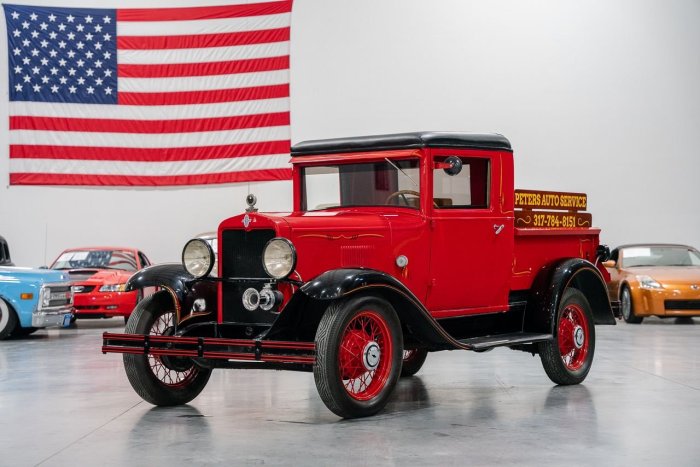
The 1929 Chevrolet truck stands as a timeless symbol of American automotive innovation. Its influence extends beyond its original purpose, inspiring generations of truck designers and captivating enthusiasts with its classic charm. Whether admired for its historical significance or cherished for its enduring functionality, the 1929 Chevrolet truck continues to hold a special place in the hearts of those who appreciate the enduring legacy of American automotive history.